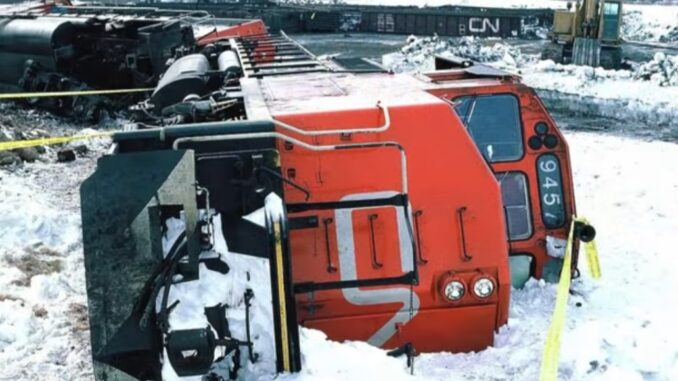
East of Maine, the Canadian province of New Brunswick lies on the Gulf of St. Lawrence, alongside Nova Scotia and Prince Edward Island. Bathurst is a harbour town in the north of New Brunswick. A rail line owned and operated by Canadian National Railways (CN) serves industries in the region, including lumber and mining interests. Brunswick Mine is a huge operation that produces ore from which antimony, bismuth, cadmium, copper, gold, lead, silver, and zinc are derived. Trains transport the raw ore from the mines to processing plants closer to the nearby city of Brunswick.
On March 9, 1987, a railroad crew at Brunswick Mine was preparing an ore train for departure. This procedure involved connecting up to 23 fully-loaded ore cars at a time to a pair of diesel locomotives. Engineer Wesley MacDonald (age 60) relied on other crewmembers to connect no more than 23 cars at a time, as this was the limit of what the engines could effectively brake without the air brake lines hooked up. When hooked up, the air lines actuated the brakes on each and every car. However, it was common practice then not to connect the air brake lines until the train was fully assembled with all cars connected.
MacDonald didn’t know it until it was too late, but a total of 31 ore cars had been connected to the engines instead of the required limit of 23. He pulled the string of cars forward, then tried to stop after a certain distance, but the cars would not yield. They had too much inertia, and their combined mass was far too much for the engine’s brakes. Too make matters worse, they were on a slope, with gravity pulling on the cars, urging them to keep rolling. MacDonald called on the radio to let the switchyard dispatcher know what was happening.
MacDonald tried everything he could to try to stop the massive load, but no dice. He elected to stay with the runaway train, which was picking up speed on the downward slope toward the city of Brunswick. By staying on board, he was able to blow the diesel air horn at railroad crossings, warning the public to stay clear. The train continued to pick up speed for the next twenty minutes. After nearly 15 miles of downhill travel, it had almost reached 70 miles an hour, but this was as far as it would go. The tracks curved steeply to the right at a place called Nepisiguit Junction, and the train was moving too fast now to make the curve.
Fortunately for MacDonald, he anticipated this would be the derailing point, and he’d prepared for it by moving back to the cab of the second engine and bracing himself. He escaped the wreck with nothing more than scrapes and bruises.
“Nepisiguit Runaway train 34 years later” (17:26)
